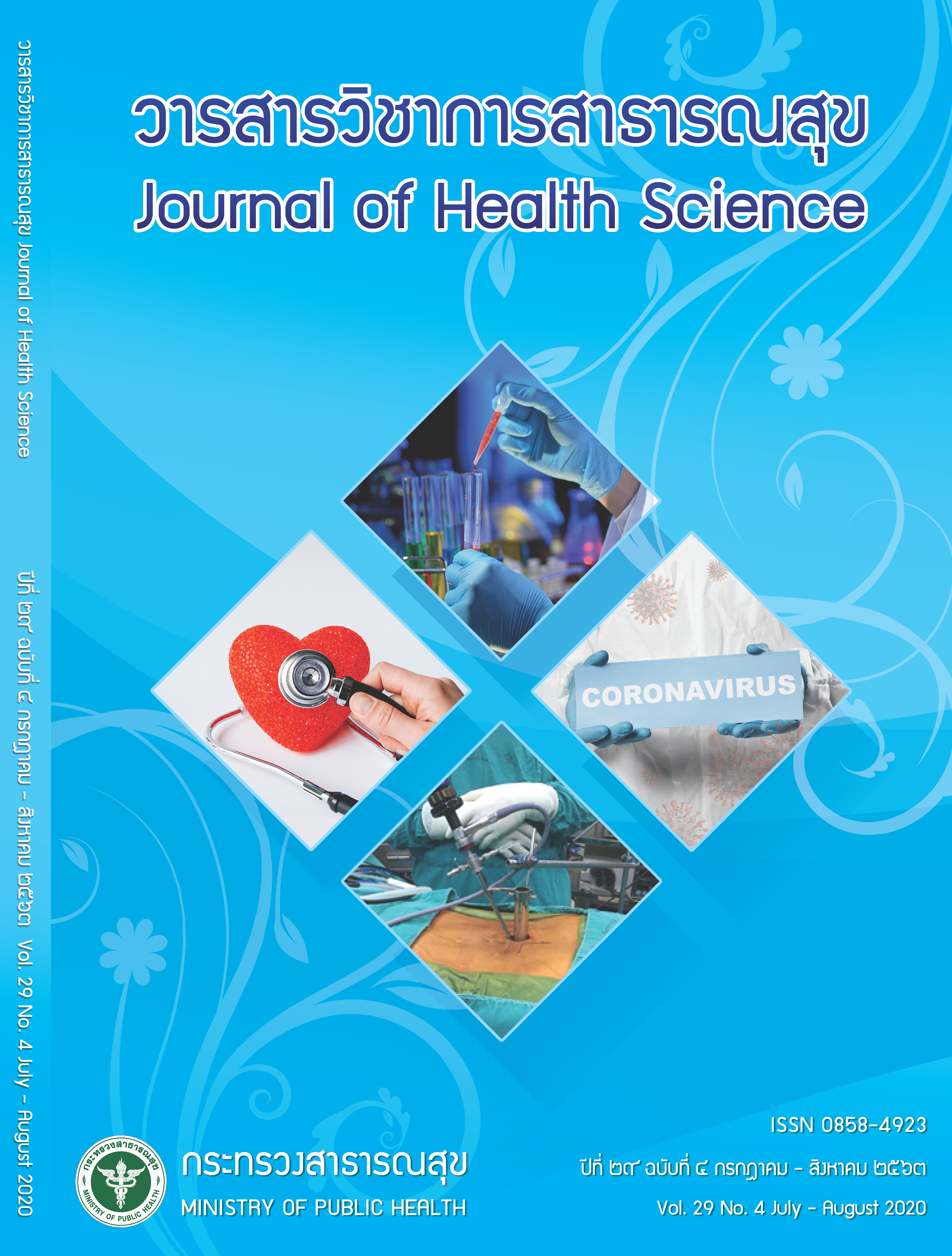Efficacy Evaluation of Deltamethrin and Cypermethrin Against Insecticide-resistant and -susceptible Strains of Dengue Vector Aedes aegypti
Keywords:
Aedes aegypti, dengue fever, deltamethrin, cypermethrin, insectAbstract
The objective of this study was to assess knockdown and insecticidal effects of deltamethrin and cypermethrin in order to identify appropriate concentration of the chemicals for the control of insecticide resistant strains of Aedes aegypti, the dengue vector in Thailand. The concentration used in this study was at 0.025, 0.05, 0.1, 0.15 and 0.2 g a.i./m2; and the mosquitoes were Aedes aegypti strains from Rayong and Chanthaburi Provinces compared with laboratory susceptible strain using World Health Organization susceptibility test. It was found that the two field populations of Ae. aegypti showed moderate resistance to deltamethrin and high resistance to cypermethrin. The toxic effect of deltamethrin was observed at the doses of 0.15 and 0.2 g a.i./m2with 100.0% mortality in both field populations while cypermethrin gave 91.3-97.0% mortality for Rayong population and 89.8-92.4% mortality for Chanthaburi population. Deltamethrin also provided a faster knockdown effect than cypermethrin. Therefore, further studies are needed to evaluate the residual effect of deltamethrin applied with the active ingredient at 0.15 and 0.2 g/m2. Spraying residual insecticides on potential resting places of adult Ae. aegypti, especially in dengue endemic areas facing insecticide resistance in dengue vectors, can be considered a supplementary method to be used in combination with the major methods (insecticide space-spraying and larviciding) for dengue vector control.
Downloads
References
Thongrungkiat S, Maneekan P, Wasinpiyamongkol L, Prummongkol S. Prospective field study of transo-varial dengue-virus transmission by two different forms of Aedes aegypti in an urban area of Bangkok, Thailand. J Vector Ecol 2011;36(1):147-52.
สำนักโรคติดต่อนำโดยแมลง. หนังสือรายงานประจำปี 2559 สำนักโรคติดต่อนำโดยแมลง. กรุงเทพมหานคร: อักษรกราฟฟิ คแอนด์ดีไซน์; 2560.
Rozendaal JA, World Health Organization. Vector con-trol: methods for use by individuals and communities. Geneva: World Health Organization; 1997.
Hladish TJ, Pearson CAB, Patricia Rojas D, Go-mez-Dantes H, Halloran ME, Vazquez-Prokopec GM, et al. Forecasting the effectiveness of indoor residual spray-ing for reducing dengue burden. PLoS Negl Trop Dis 2018;12(6):e0006570.
Lei W, Wang DD, Dou TY, Hou J, Feng L, Yin H, et al. Assessment of the inhibitory effects of pyrethroids against human carboxylesterases. Toxicol Appl Pharma-col 2017;321:48-56.
วิชัย สติมัย. การศึกษาการใช้สารเคมีและความต้านทานของยุงพาหะต่อสารเคมีในภาคตะวันออกของประเทศไทย. วารสารโรคติดต่อนำโดยแมลง 2553;7(2):18-30.
สำนักโรคติดต่อนำโดยแมลง. หนังสือรายงานประจำปี 2560 สำนักโรคติดต่อนำโดยแมลง. กรุงเทพมหานคร: อักษรกราฟฟิ คแอนด์ดีไซน์; 2561.
สำนักโรคติดต่อนำโดยแมลง. สรุปรายงานสถานการณ์โรคไข้เลือดออก พ.ศ. 2558-2559 [อินเทอร์เน็ต]. [สืบค้นเมื่อ 27 ก.ค. 2561]. แหล่งข้อมูล: http://www.thaivbd.org/dengue_history.php
World Health Organization. Test procedures for insecti-cide resistance monitoring in malaria vectors, bio-effi-cacy and persistence of insecticides on treated surfaces. Geneva: World Health Organization; 1998.
World Health Organization. Test procedures for insecti-cide resistance monitoring in malaria vevtor mosquitoes. Second edition. Geneva: World Health Organization; 2016.
สิทธิพร นามมา, วาสนา สอนเพ็ง, ศศิธร แพนสมบัติ. การทดสอบความไวของยุงลายต่อสารกำจัดแมลงกลุ่มไพรีทรอยด์สังเคราะห์. วารสารสำนักงานป้ องกันควบคุมโรคที่ 7 จังหวัดขอนแก่น 2557;21(1):87-96.
Abbott WS. A method for computing the effectiveness of an insecticide. 1925. J Am Mosq Control Assoc 1987;3(2):302-3.
Jirakanjanakit N, Bongnoparut P, Saengtharatip T, Yok-san S. Insecticide susceptible/resistance status in Aedes (Stegomyia) albopictus (Diptera: Culicidae) in Thailand during 2003-2005. J Econ Entomol 2007;100(2):545-50.
Paeporn P, Supaphathom K, Sisawat R, Komalamisra N, Deesin V, Ya-umphan P, et al. Biochem detection of pyrethroid resistance mechanisms in Aedes aegypti in Ratchaburi province Thailand. Trop Biomed 2004; 21(2):145-51.
Thanispong K, Sathantriphop S, Chareonviriyaphap T. Insecticide resistance of Aedes aegypti and Culex quinquefasciatus in Thailand. J Pestic Sci 2008;33(4):351-6.
คณัจฉรีย์ ธานิสพงศ์, ขนิษฐา ปานแก้ว, ประชา สุขโชติ. ความไว/ความต้านทานสารเคมีกำจัดแมลงของยุงลายบ้านต่อสารเคมีกำจัดแมลงที่ใช้ในงานสาธารณสุข. วารสารโรค-ติดต่อนำโดยแมลง 2554;8(2):28-43.
Thongwat D, Bunchu N. Susceptibility to temephos, permethrin and deltamethrin of Aedes aegypti (Diptera: Culicidae) from Muang district, Phitsanulok Province, Thailand. Asian Pac J Trop Med 2015;8(1):14-8.
ทัศนีย์ เอกวานิช, ยุวดี ตรงต่อกิจ, สุวิทย์ เพ็งพิศ. ความไวของยุงลายบ้านและยุงรำคาญต่อสารเดลต้ามิทรินในเขตเทศบาลนครภูเก็ต. วารสารวิชาการสาธารณสุข 2557; 23(6):1108-14.
Floore TG, Rathburn CB Jr, Boike AH Jr, Coughlin JS, Greer MJ. Comparison of the synthetic pyrethroids es-biothrin and bioresmethrin with scourge and cythion against adult mosquitoes in a laboratory wind tunnel. J Am Mosq Control Assoc 1992;8(1):58-61.
Davies TG, Field LM, Usherwood PN, Williamson MS. DDT, pyrethrins, pyrethroids and insect sodium channels. International Union of Biochemistry and Molecular Bi-ology Life 2007;59(3):151-62.
CheMendoza A, Guillermo-May G, Herrera-Bojórquez J, Barrera-Pérez M, Dzul-Manzanilla F, Gutierrez-Cas-tro C, et al. Long-lasting insecticide treated house screens and targeted treatment of productive breeding-sites for dengue vector control in Acapulco, Mexico. Trans R Soc Trop Med Hyg 2015;109(2):106-15.
Mushtaq S, Mukhtar MU, Arslan A, Zaki AB, Hammad M, Bhatt A. Probing the residual effects of deltamethrin on different surfaces against malaria and dengue vector in Pakistan by designing laboratory model. J Entomol Zool Stud 2015;3(4):440-3
Insecticide Resistance Action Committee (IRAC). Pre-vention and management of insecticide resistance in vectors of public health importance. 2nd edition [Internet]. 2011 [cited 2018 Jul 27]. Available from: https://irac-online.org/content/uploads/2009/09/VM-Lay-out-v2.6_LR.pdf
Downloads
Published
How to Cite
Issue
Section
License

This work is licensed under a Creative Commons Attribution-NonCommercial-NoDerivatives 4.0 International License.







